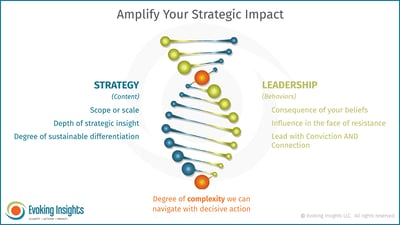You have been preparing for this strategic planning meeting and presentation for weeks, even years—doing everything in your power to lay the foundation for this decisive moment. You and your team have analyzed data, crafted the story, run experiments, clarified focus, and quantified the expected impact of your recommendations. So much preparation to inform and influence a single decision that will transform the business.
Now it’s here: The strategy and planning meeting with the C‑suite executive team at a large life sciences company. Despite having plenty of time on the agenda, you spark such a substantive strategic conversation it continues for an hour beyond your allotted time. You return to your hotel room—exhausted, pleased by the quality of conversation, and…wondering:
What decision will the executives make?
- Will they choose to lead the market transformation?
- Will they make a choice that requires fundamentally shifting the business model, sources of value creation, and core capabilities?
You get the call the next day: They will not pursue your recommended direction.
Disappointment washes over you. So much time and effort envisioning a path you see as critical for the organization. Frustration and discouragement are bound to follow—feeling like you failed and “didn’t make the sale.”
The stress and fatigue in your body trigger a downward spiral, surfacing fears about your strategic leadership abilities. Did you lose credibility? You are your own worst critic, and you wonder: How did I get it so wrong?
So, what might you have gotten wrong? What could you have done differently?
At any moment, we can amplify our strategic impact through one or both DNA strands of strategic leadership.
-
Strategy strand: Higher quality, more robust strategic thinking with increasing complexity
-
Leadership strand: Greater influence and aligned action through the courage of your convictions AND connections
Robust Strategic Thinking and Decision‑Making
As the world becomes more complex, your strategic leadership credibility increasingly comes from the quality of your strategic thinking and insight. This, in turn, influences the quality of strategic conversations and decisions.
Before you spiral, reflect on these three key considerations to see if this is where you “got it wrong.”
1. Set the Context
Strategy is about changing the organization to create the next source(s) of competitive advantage and remain well‑positioned in an ever‑changing market environment. A robust case for change is paramount to breaking free of the status quo.
Did you ground the conversation in the substantive aspects of change in the market context (such as customer types, customer needs, competitors, regulations)? Did you distill it into the most critical strategic problem your recommended shift in strategic direction will address?
For example:
-
Distribution channel partners don’t sufficiently value our offering
-
Insignificant product portfolio breadth
-
Market penetration rate (low relative to total opportunity)
-
Competitive response to strategic moves (for example, technology leapfrog, making yours obsolete)
As famous General Motors inventor Charles Kettering said, “A problem well framed is half‑solved.”
2. Frame the Options and Trade‑Offs
With the executives’ attention focused on the strategic issues/opportunities that matter most, your next job is to frame the discussion in a way that enables people to make a meaningful choice.
Too often, leaders try to “sell” a recommendation instead of enabling robust strategic thinking and necessary direction‑setting choices. Tough choices. Decisions that cut off certain options in favor of the strategic bet on the winning strategy.
When there is more than one option to solve the strategic problem, elements of the optimal solution emerge through the discussion. You will know options are well‑framed when:
- There is meaningful trade‑off between them in terms of investment priorities, focus, and risk. Each option should provide a clear sense of opportunities to pursue or forego, leading to different outcomes and positioning in the marketplace.
- All options are attractive and viable. Anything less doesn’t force tough choices about where to focus your efforts and resources.
For example:
Strategic problem: distribution channel partners don’t value your offering the way they used to, which could ultimately threaten profitable access to your end customers.
Strategic options:
- Fundamentally alter your offering to restore the existing channel’s enthusiasm.
- Abandon this channel and develop a relationship with a different set of channel partners.
3. Discover and Trust in Your Depth of Strategic Insight
Setting strategy is a thinking process. Robust strategy is rooted in quality strategic insight(s). Insights that reveal new ways of defining and satisfying customer needs and competing more effectively.
Strategic insights are among the more enigmatic elements of developing a sustainably differentiated strategy. These are often referred to as “ah‑ha” moments, or moments of seeing what had been elusive until then. Insights generate energy and set a new direction based on a fundamentally different way of making meaning.
Insight emerges from our ability and willingness to consider alternative ways of viewing the world—identifying patterns and forging new connections. They are intuitive and creative—and their emergence cannot be controlled. Curiosity, receptivity, and consistently dedicating time to think are essential ingredients. You can strengthen your capacity to generate insights by taking the time to reflect, challenge, iterate, and refine new ways of seeing the world.
Then trust in your instincts, intuition, and strategic acumen. Because acting on strategic insight requires a leap of faith as you create new realities. It can challenge conventional wisdom, causing you to face doubt and resistance. Belief must guide you until you have the benefit of hindsight, to potentially prove an insight’s value.
The Mindset of a Game‑Changing Strategic Leader
After reflecting on the meeting, you feel more confident that the strategic thinking was robust. Your options were grounded in market and operational realities and in distinct insights. The conversation that ensued confirmed the quality of your strategic thinking, framing, and storytelling.
So, what went wrong…?
What if the only thing wrong was your mindset?
What if these meetings aren’t about “getting it right?”
What if, at this level of strategic leadership, the goal isn’t to get your recommendation endorsed, but rather to shape and advance the thinking of the executives on one of the most substantive opportunities available to the organization? What if your way was the means to a better way?
Mind‑blowing, I know. It’s a dichotomy.
As a business leader, it’s your job to have insight into what is needed to continually evolve the business to be well‑positioned in that ever‑changing marketplace. As such, it is your job to advocate, inspire, and influence others to see the future you seek to create.
On the other hand, you recognize that strategic decisions are complex - especially bold and transformational moves. Strategy is not a linear equation that can be solved with enough expertise. The degree of change, interconnectivity, and unpredictability requires a different type of leadership to navigate such complexity and uncertainty. The past is no longer a predictor of the future.
What if, instead of trying to be the expert, you trust in your contributions AND tap into the diverse minds, perspectives, and experiences of these leaders to co‑create the future of the organization?
You would have conviction of your ideas because you’ve done the research and engaged in robust strategic thinking—AND you would remain objective, receptive, curious, and detached from your singular view of the way things need to be. Advocacy AND inquiry.
It is a tall order for a leader. Especially when forging an alternate path may have personal consequences related to your role. This is enterprise‑level leadership that results in genuine dialogue, debate, and high‑quality strategic decisions in the face of ever‑increasing complexity.
My client, Renaldo, has been experimenting with this different mindset for a couple of years now. When we started our work, he had what we called the “gold‑star mindset”—like back in grade school—where he assessed the “success” of meetings by evaluating his effectiveness at convincing others to see what he saw. He has worked to shift to the mindset of a creator and transformer. With this mindset, in strategy conversations he is part of a team with a shared outcome. A team in which C‑suite executives are collaborators, not evaluators.
It is a huge shift from how he led just a year ago. The more he embraces the not knowing of game‑changing strategic leadership, the more respected and credible a leader he becomes.
Navigating Complexity: The Nexus of Strategy and Leadership
At the nexus of strategy and leadership is greater strategic impact and an ability to lead decisively through increasing complexity. Complexity and uncertainty that require more and more trust. Trust in your strategic thinking acumen. Trust in yourself as a creator—looking less to others for that “gold star” approval. And trust in your colleagues to have your back, to work collaboratively in the best interest of the organization. To not judge or evaluate, but rather co‑create with you.
Uncertainty can bring out reactive versions of ourselves—defensive, judgmental, close‑minded, and distrusting. Yet we all have the capacity to cultivate the most resourceful and creative version of ourselves and our colleagues. The version that can navigate an ever more complex and dynamic world.
So, what if you lead from that version of yourself?
How might you approach your next executive strategy discussion? How might you deepen your strategic insight or experiment with the mindset of a creator and transformer on your path to game‑changing strategic leadership?



